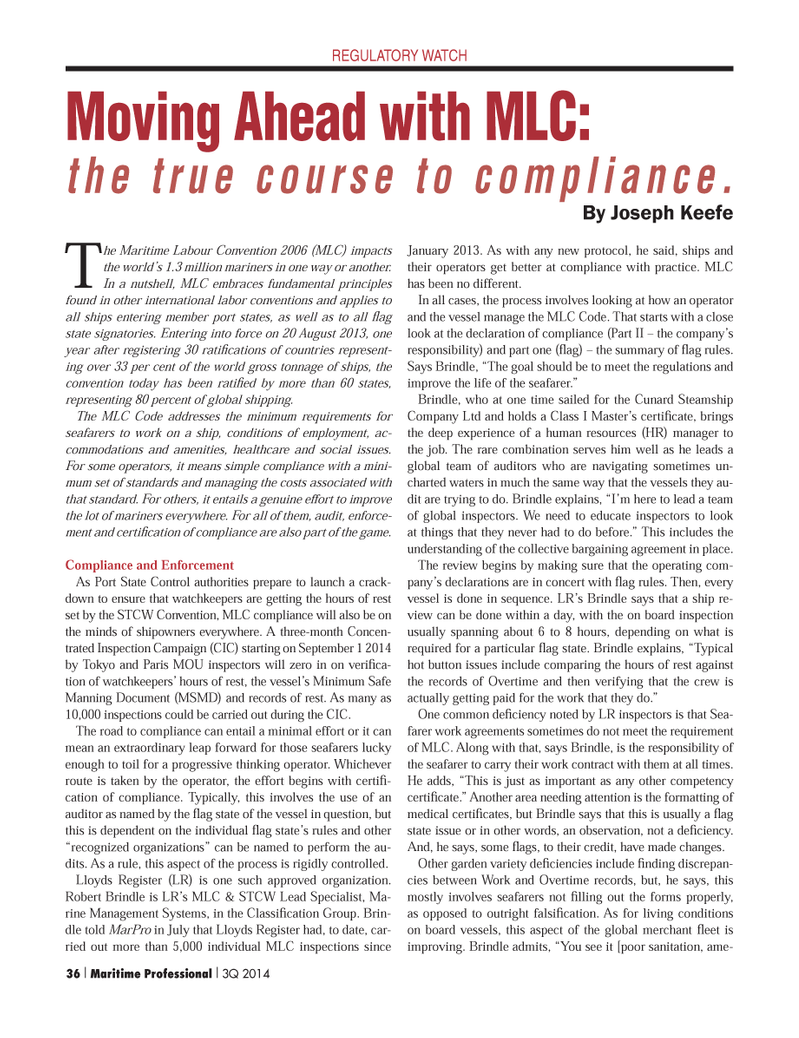
Page 36: of Maritime Logistics Professional Magazine (Q3 2014)
Power & Fuel Management
Read this page in Pdf, Flash or Html5 edition of Q3 2014 Maritime Logistics Professional Magazine
REGULATORY WATCH The Maritime Labour Convention 2006 (MLC) impacts the world?s 1.3 million mariners in one way or another. In a nutshell, MLC embraces fundamental principles found in other international labor conventions and applies to all ships entering member port states, as well as to all ag state signatories. Entering into force on 20 August 2013, one year after registering 30 rati cations of countries represent- ing over 33 per cent of the world gross tonnage of ships, the convention today has been rati ed by more than 60 states, representing 80 percent of global shipping. The MLC Code addresses the minimum requirements for seafarers to work on a ship, conditions of employment, ac- commodations and amenities, healthcare and social issues. For some operators, it means simple compliance with a mini- mum set of standards and managing the costs associated with that standard. For others, it entails a genuine effort to improve the lot of mariners everywhere. For all of them, audit, enforce- ment and certi cation of compliance are also part of the game . Compliance and Enforcement As Port State Control authorities prepare to launch a crack-down to ensure that watchkeepers are getting the hours of rest set by the STCW Convention, MLC compliance will also be on the minds of shipowners everywhere. A three-month Concen- trated Inspection Campaign (CIC) starting on September 1 2014 by Tokyo and Paris MOU inspectors will zero in on veriÞ ca-tion of watchkeepersÕ hours of rest, the vesselÕs Minimum Safe Manning Document (MSMD) and records of rest. As many as 10,000 inspections could be carried out during the CIC.The road to compliance can entail a minimal effort or it can mean an extraordinary leap forward for those seafarers lucky enough to toil for a progressive thinking operator. Whichever route is taken by the operator, the effort begins with certiÞ -cation of compliance. Typically, this involves the use of an auditor as named by the ß ag state of the vessel in question, but this is dependent on the individual ß ag stateÕs rules and other Òrecognized organizationsÓ can be named to perform the au- dits. As a rule, this aspect of the process is rigidly controlled. Lloyds Register (LR) is one such approved organization. Robert Brindle is LRÕs MLC & STCW Lead Specialist, Ma- rine Management Systems, in the ClassiÞ cation Group. Brin- dle told MarPro in July that Lloyds Register had, to date, car- ried out more than 5,000 individual MLC inspections since January 2013. As with any new protocol, he said, ships and their operators get better at compliance with practice. MLC has been no different. In all cases, the process involves looking at how an operator and the vessel manage the MLC Code. That starts with a close look at the declaration of compliance (Part II Ð the companyÕs responsibility) and part one (ß ag) Ð the summary of ß ag rules. Says Brindle, ÒThe goal should be to meet the regulations and improve the life of the seafarer.Ó Brindle, who at one time sailed for the Cunard Steamship Company Ltd and holds a Class I MasterÕs certiÞ cate, brings the deep experience of a human resources (HR) manager to the job. The rare combination serves him well as he leads a global team of auditors who are navigating sometimes un- charted waters in much the same way that the vessels they au- dit are trying to do. Brindle explains, ÒIÕm here to lead a team of global inspectors. We need to educate inspectors to look at things that they never had to do before.Ó This includes the understanding of the collective bargaining agreement in place. The review begins by making sure that the operating com- panyÕs declarations are in concert with ß ag rules. Then, every vessel is done in sequence. LRÕs Brindle says that a ship re- view can be done within a day, with the on board inspection usually spanning about 6 to 8 hours, depending on what is required for a particular ß ag state. Brindle explains, ÒTypical hot button issues include comparing the hours of rest against the records of Overtime and then verifying that the crew is actually getting paid for the work that they do.Ó One common deÞ ciency noted by LR inspectors is that Sea- farer work agreements sometimes do not meet the requirement of MLC. Along with that, says Brindle, is the responsibility of the seafarer to carry their work contract with them at all times. He adds, ÒThis is just as important as any other competency certiÞ cate.Ó Another area needing attention is the formatting of medical certiÞ cates, but Brindle says that this is usually a ß ag state issue or in other words, an observation, not a deÞ ciency. And, he says, some ß ags, to their credit, have made changes. Other garden variety deÞ ciencies include Þ nding discrepan- cies between Work and Overtime records, but, he says, this mostly involves seafarers not Þ lling out the forms properly, as opposed to outright falsiÞ cation. As for living conditions on board vessels, this aspect of the global merchant ß eet is improving. Brindle admits, ÒYou see it [poor sanitation, ame- Moving Ahead with MLC: the true course to compliance.By Joseph Keefe 36 I Maritime Professional I 3Q 201434-49 Q3 MP2014.indd 3634-49 Q3 MP2014.indd 368/13/2014 3:07:35 PM8/13/2014 3:07:35 PM

 35
35

 37
37
